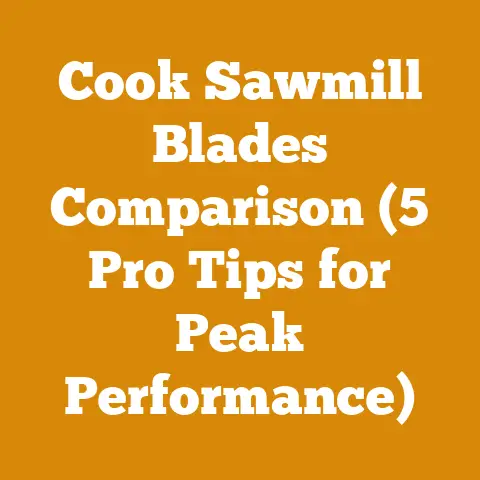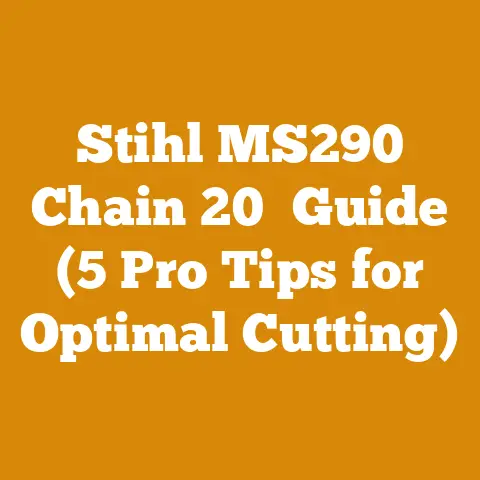Drill Bit for Drilling Metal (5 Pro Tips for Woodworkers)
Let’s dive into the world of drill bits and metal, specifically tailored for us woodworkers.
Drill Bit for Drilling Metal (5 Pro Tips for Woodworkers)
As a woodworker, I’ve often found myself needing to drill through metal.
Whether it’s reinforcing a wooden structure with steel brackets, installing hardware, or even repurposing metal scraps for artistic projects, the ability to accurately and cleanly drill metal is a skill worth mastering.
I’ve learned the hard way that using the wrong drill bit, or the wrong technique, can lead to frustration, broken bits, and damaged materials.
So, let’s cut to the chase and explore the best drill bits for metal and my top 5 tips for successful drilling.
Understanding the Challenge: Wood vs. Metal
Wood and metal are vastly different materials, and their distinct properties demand different approaches to drilling.
Wood is relatively soft and fibrous, allowing wood drill bits to quickly bore through with aggressive cutting edges.
Metal, on the other hand, is hard and dense, requiring drill bits with exceptional hardness and heat resistance.
Using a wood drill bit on metal is a recipe for disaster – you’ll quickly dull the bit, generate excessive heat, and likely fail to penetrate the metal at all.
Choosing the Right Drill Bit: A Metalworking Arsenal
Selecting the correct drill bit is paramount.
Here are my go-to choices, honed over years of experience in my own workshop.
1. High-Speed Steel (HSS) Drill Bits: The Versatile Workhorse
HSS drill bits are a staple in any workshop.
They are made from high-carbon steel that’s been hardened and tempered, making them suitable for drilling through a variety of metals, including aluminum, brass, copper, and mild steel.
- Pros: Relatively inexpensive, readily available, and versatile.
- Cons: Can dull quickly when used on hardened steel or stainless steel.
- My Experience: I use HSS bits extensively for drilling pilot holes in metal brackets before attaching them to wooden frames.
The key is to use a slow speed and plenty of cutting fluid.
2. Cobalt Drill Bits: For the Tough Stuff
Cobalt drill bits are made from HSS with an added percentage of cobalt.
This addition significantly increases the bit’s hardness and heat resistance, making them ideal for drilling through hardened steel, stainless steel, and cast iron.
- Pros: Excellent heat resistance, longer lifespan than HSS bits, and effective on tough metals.
- Cons: More expensive than HSS bits, can be brittle if not used correctly.
- My Experience: I’ve relied on cobalt bits when working with salvaged steel components.
Their ability to withstand heat and maintain their cutting edge is invaluable.
3. Titanium-Coated Drill Bits: Enhanced Performance
Titanium-coated drill bits are HSS bits with a thin layer of titanium nitride (TiN) coating.
This coating provides increased surface hardness, reduces friction, and extends the lifespan of the bit.
- Pros: Improved wear resistance, reduced friction, and longer lifespan compared to standard HSS bits.
- Cons: The coating can wear off over time, reducing the bit’s performance.
- My Experience: I find titanium-coated bits to be a good middle ground between HSS and cobalt.
They offer a noticeable improvement in performance without the hefty price tag of cobalt bits.
4. Carbide-Tipped Drill Bits: Extreme Duty
Carbide-tipped drill bits feature a carbide cutting edge brazed onto a steel body.
Carbide is an exceptionally hard and heat-resistant material, making these bits suitable for drilling through extremely hard materials like hardened steel, cast iron, and even some types of ceramics.
- Pros: Exceptional hardness, excellent heat resistance, and long lifespan.
- Cons: Most expensive type of drill bit, can be brittle and prone to chipping if not used carefully.
- My Experience: I reserve carbide-tipped bits for specialized applications where I need to drill through particularly tough materials.
They are a significant investment, but their performance is unmatched.
5. Step Drill Bits (Unibits): The Hole Enlargement Specialist
Step drill bits, also known as unibits, are designed to drill holes of varying sizes.
They have a stepped cone shape, with each step representing a different hole diameter.
- Pros: Versatile for drilling multiple hole sizes, deburrs holes as it drills, and reduces the risk of walking.
- Cons: Limited to drilling specific hole sizes, not suitable for drilling blind holes.
- My Experience: I find step drill bits incredibly useful for enlarging existing holes in metal enclosures or for creating clean, consistent holes in sheet metal.
Pro Tip #1: Speed Kills (or at least dulls)
One of the biggest mistakes I see woodworkers make when drilling metal is using too much speed.
Metal requires a much slower drilling speed than wood.
High speeds generate excessive heat, which can quickly dull the drill bit and even harden the metal, making it even more difficult to drill.
- The Science: High-speed drilling generates friction, which translates directly into heat.
This heat can soften the drill bit, causing it to lose its cutting edge. - The Solution: Reduce the drilling speed significantly.
A good rule of thumb is to use the lowest speed setting on your drill and apply consistent pressure.
Refer to a speed chart for specific RPM recommendations based on the type of metal and drill bit you’re using. - My Experience: I learned this lesson the hard way, burning through several HSS bits before realizing my mistake.
Now, I always start with a slow speed and gradually increase it until I find the optimal drilling rate.
Actionable Metric: Use a drill speed chart as a reference.
For example, when drilling mild steel with a 1/4″ HSS bit, aim for around 1500-2500 RPM.
Pro Tip #2: Lubrication is Key: Keeping Things Cool and Smooth
Friction is the enemy of any drilling operation, especially when working with metal.
Cutting fluid, also known as cutting oil or lubricant, helps to reduce friction, dissipate heat, and prevent the drill bit from binding in the hole.
- The Science: Cutting fluid acts as a coolant, drawing heat away from the cutting edge of the drill bit.
It also lubricates the interface between the bit and the metal, reducing friction and making it easier for the bit to cut. - The Solution: Apply cutting fluid liberally to the drilling area before and during drilling.
There are several types of cutting fluids available, including oil-based, water-soluble, and synthetic fluids.
Choose a fluid that is appropriate for the type of metal you’re drilling. - My Experience: I’ve experimented with different cutting fluids over the years, and I’ve found that a general-purpose cutting oil works well for most of my metal drilling applications.
I keep a small bottle of cutting oil handy in my workshop and apply it frequently during drilling. - DIY Option: If you don’t have cutting fluid on hand, you can use motor oil or even WD-40 as a temporary substitute.
However, these alternatives are not as effective as dedicated cutting fluids.
Actionable Metric: Aim to apply cutting fluid every 5-10 seconds during drilling.
Pro Tip #3: Center Punch Precision: Starting Off Right
One of the most frustrating things that can happen when drilling metal is having the drill bit “walk” or wander off the intended drilling location.
This can lead to inaccurate holes and damaged materials.
A center punch is a simple tool that helps to prevent this problem.
- The Science: A center punch creates a small indentation in the metal surface, providing a starting point for the drill bit.
This indentation helps to guide the bit and prevent it from slipping or wandering. - The Solution: Before drilling, use a center punch and hammer to create a small indentation at the precise location where you want to drill the hole.
Apply firm, even pressure to the center punch and strike it sharply with the hammer. - My Experience: I always use a center punch, even for small holes.
It only takes a few seconds, and it significantly improves the accuracy of my drilling.
I prefer a spring-loaded center punch, which eliminates the need for a hammer and provides consistent pressure. - Alternative: If you don’t have a center punch, you can use a nail or a hardened steel punch as a substitute.
However, a dedicated center punch is the best tool for the job.
Actionable Metric: The indentation created by the center punch should be deep enough to guide the drill bit, but not so deep that it distorts the metal.
Pro Tip #4: Pressure and Patience: The Gentle Approach
Applying the right amount of pressure is crucial for successful metal drilling.
Too little pressure, and the drill bit will simply spin without cutting.
Too much pressure, and you risk overheating the bit, work hardening the metal, or even breaking the bit.
- The Science: The goal is to apply enough pressure to allow the drill bit to cut efficiently without generating excessive heat or stress.
The optimal pressure will vary depending on the type of metal, the size of the drill bit, and the drilling speed. - The Solution: Apply consistent, moderate pressure to the drill.
Let the drill bit do the work.
Avoid forcing the bit.
If the bit is not cutting, increase the pressure slightly.
If the bit is generating excessive heat or squealing, reduce the pressure. - My Experience: I’ve found that a gentle, steady approach is usually the most effective.
I focus on maintaining a consistent pressure and letting the drill bit gradually work its way through the metal. - Listen to the Sound: Pay attention to the sound of the drilling.
A smooth, consistent sound indicates that the bit is cutting efficiently.
A squealing or chattering sound indicates that the bit is overheating or binding.
Actionable Metric: Aim for a consistent stream of metal shavings (chips) coming out of the hole.
This indicates that the bit is cutting efficiently.
Pro Tip #5: Deburring and Finishing: The Polished Touch
Once you’ve drilled the hole, it’s important to deburr the edges and clean up any sharp edges.
This will improve the appearance of the hole and prevent injuries.
- The Science: Drilling creates burrs, which are sharp, raised edges around the hole.
These burrs can be dangerous and can also interfere with the fit of fasteners or other components. - The Solution: Use a deburring tool, a countersink bit, or a file to remove the burrs from the edges of the hole.
A deburring tool is specifically designed for this purpose and is the most efficient option.
A countersink bit can be used to create a chamfered edge around the hole.
A file can be used to manually remove the burrs. - My Experience: I always deburr my holes, even if they are not visible.
It’s a quick and easy step that makes a big difference in the overall quality of the finished product.
I prefer to use a deburring tool for most applications, as it’s fast and effective. - Safety First: Always wear safety glasses when deburring metal, as small pieces of metal can fly off and cause eye injuries.
Actionable Metric: Run your finger around the edge of the hole to check for burrs.
The edge should be smooth and free of sharp edges.
Beyond the Basics: Advanced Techniques for Metal Drilling
Once you’ve mastered the basic techniques, you can explore some more advanced techniques for metal drilling.
Pilot Holes: A Foundation for Larger Holes
When drilling large holes in metal, it’s always a good idea to drill a pilot hole first.
A pilot hole is a small hole that is drilled to guide the larger drill bit and prevent it from walking.
- The Science: A pilot hole provides a stable starting point for the larger drill bit, making it easier to drill an accurate and clean hole.
- The Solution: Choose a drill bit that is slightly smaller than the final desired hole size.
Drill a pilot hole using the techniques described above.
Then, use a larger drill bit to enlarge the hole to the final size. - My Experience: I always drill pilot holes when drilling holes larger than 1/4″.
It significantly reduces the risk of the larger bit walking or binding.
Tapping: Creating Threads in Metal
Tapping is the process of creating threads in a hole so that it can accept a screw or bolt.
- The Science: Tapping involves using a tap, which is a tool with hardened cutting edges, to cut threads into the metal.
- The Solution: Drill a hole that is slightly smaller than the diameter of the tap.
Use a tap handle to turn the tap into the hole, applying consistent pressure.
Use cutting fluid to lubricate the tap and prevent it from binding. - My Experience: I’ve tapped threads in metal for a variety of applications, from repairing damaged threads to creating custom fasteners.
It’s a useful skill to have, but it requires practice and patience.
Countersinking: Creating a Flush Finish
Countersinking is the process of creating a conical depression around a hole so that the head of a screw or bolt can sit flush with the surface of the metal.
- The Science: Countersinking involves using a countersink bit to create a conical depression in the metal.
- The Solution: Choose a countersink bit that is appropriate for the size of the screw or bolt you’re using.
Use the countersink bit to create a conical depression around the hole. - My Experience: I use countersinking frequently when attaching hardware to metal surfaces.
It creates a clean, professional look and prevents the heads of the screws or bolts from protruding.
Safety First: Protecting Yourself in the Workshop
Metal drilling can be a dangerous activity if proper safety precautions are not taken.
- Eye Protection: Always wear safety glasses to protect your eyes from flying metal chips.
- Hand Protection: Wear gloves to protect your hands from sharp edges and hot metal.
- Hearing Protection: Wear earplugs or earmuffs to protect your hearing from the noise of the drill.
- Clothing: Avoid wearing loose clothing or jewelry that could get caught in the drill.
- Ventilation: Work in a well-ventilated area to avoid inhaling fumes from cutting fluids.
Maintaining Your Drill Bits: Extending Their Lifespan
Proper maintenance is essential for extending the lifespan of your drill bits.
- Cleaning: Clean your drill bits after each use to remove metal shavings and cutting fluid.
- Sharpening: Sharpen your drill bits regularly to maintain their cutting edge.
A dull drill bit will generate more heat and be more likely to break. - Storage: Store your drill bits in a dry place to prevent rust.
Troubleshooting Common Drilling Problems
Even with the best techniques, you may encounter problems when drilling metal.
Here are some common problems and their solutions.
- Drill Bit Walking: Use a center punch to create a starting point for the drill bit.
- Drill Bit Overheating: Reduce the drilling speed and apply more cutting fluid.
- Drill Bit Binding: Reduce the pressure and apply more cutting fluid.
- Drill Bit Breaking: Use a slower drilling speed, apply less pressure, and use a higher-quality drill bit.
- Hole is Too Large: Use a smaller drill bit or drill a pilot hole first.
- Hole is Not Round: Use a drill press to ensure that the drill bit is perpendicular to the metal surface.
Conclusion: Mastering the Art of Metal Drilling
Drilling metal is a valuable skill for any woodworker.
By choosing the right drill bit, using the proper techniques, and taking the necessary safety precautions, you can drill accurate and clean holes in metal with confidence.
Remember to prioritize safety, use cutting fluid liberally, and let the drill bit do the work.
With practice and patience, you’ll be able to tackle any metal drilling project that comes your way.






